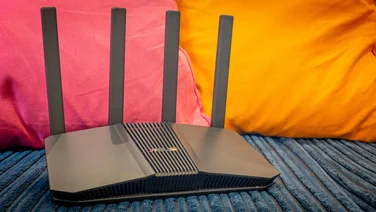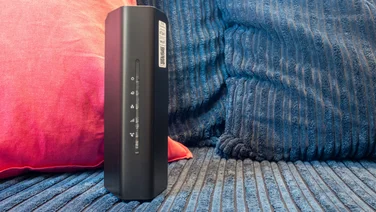To help us provide you with free impartial advice, we may earn a commission if you buy through links on our site. Learn more

- One of the cheapest Wi-Fi 6 routers around
- Good all-round feature set
- Basic security feature included
- Uninspiring performance
TP-Link’s Archer AX53 is a dual-band Wi-Fi 6 router with a low profile and a low price. Yet browse down the spec sheet and the impression is anything but cheap: in terms of both wireless hardware and software features, the AX53 matches up to rival routers costing twice as much and more.
Has TP-Link come up with the perfect bargain formula for home networking? We put the AX53 to the test to find out.
TP-Link Archer AX53 review: What you need to know
The AX53 clearly comes from the same stable as the older Archer AX50. The physical design is pretty much identical and the core specifications are the same, too: four antennas support 4×4 MU-MIMO with a maximum speed of 2.4Gbits/sec on the 5GHz band and a respectable 574Mbits/sec over the 2.4GHz radio. Like its predecessor, the AX53 also supports the wide 160MHz channel width to maximise bandwidth.
There’s no USB support but that’s forgivable on such a cheap router. And you do get a full complement of four Gigabit Ethernet sockets, plus access to TP-Link’s HomeShield service, which handles network security and advanced parental controls. For £75, it’s very hard to complain.
READ NEXT: Best VPN
TP-Link Archer AX53 review: Price and competition
The Archer AX53 is one of the cheapest Wi-Fi 6 routers we’ve seen, but it doesn’t quite take the crown. The basic Honor Router 3 has fallen as low as £40 since its introduction in 2020 – although since it’s no longer officially sold in the UK, the only way to get one now is via grey-market import.
In the mainstream market, the cheapest option is TP-Link’s own Archer AX10 – a slightly smaller brother to the AX53 that lacks MU-MIMO but knocks a tenner off the price. The compact D-Link R15 Eagle Pro AI also undercuts the AX53 at £68 (ASIN: B09FH7BLF5), while the Linksys MR7350 matches the Archer’s £75 price tag and adds a USB 3 port for sharing files across your home network.
If you’re willing to pay a little more for a router, your best bet is the Asus TUF Gaming AX5400. Don’t be put off by the gamer branding: this router has all the features a regular household needs, plus strong wireless performance for a reasonable £133.
The very best speeds however come at a steep premium. The Asus ROG Rapture GT-AX6000 wowed us with download speeds of up to 125MB/sec but will cost you £340 and, if you want to step up to the new Wi-Fi 6E standard, the best option we’ve tested so far is the Netgear Nighthawk RAXE500; yours for a mere £550.
TP-Link Archer AX53 review: Design and features
The Archer AX53 is hardly an obtrusive presence; its long, low casing has a fairly compact footprint of 260 x 135mm. However, it’s topped with very shiny black plastic, making it more eye-catching than you might expect. At the front, six LEDs show the power, internet status and so forth (although the explanatory icons are hard to read as they’re very small and angled downwards) while, at the back, those four Gigabit LAN ports are joined by a WAN socket, a WPS button and a power button. It’s a basic, functional design.
The software side is more ambitious. The AX53 runs TP-Link’s standard router firmware, with largely the same set of features as the company’s flagship models. This means you get not just port forwarding and QoS controls but also some surprisingly advanced options, such as IPv6 and ALG configuration. Those wanting to really take control of their network can configure up to four VLANs and set up static routing.

An incoming VPN server is provided, too, to allow external access to your home network, and you can give your router a consistent web address using No-IP, DynDNS or TP-Link’s own DDNS service.
The cherry on top is TP-Link’s HomeShield service, which provides basic network security scans and lets you configure bedtimes and website filtering for kids’ devices. Upgrade to HomeShield Pro and you get extra protections, such as malicious content filtering and DDoS protection, as well as more flexible parental controls and extensive reporting. It’s quite expensive, however, at £54 a year, and it can’t be managed through the web interface – you need to download the TP-Link Tether mobile app and register for an online ID. As well as handling security and parental controls, this app offers a convenient way to check on network activity, run a security scan and so forth, and it works remotely as well as over a local wireless connection.
A final feature worth mentioning is OneMesh, which lets you pair the AX53 with other TP-Link routers to create an extended network. It’s a tempting option for a router like this, as it means you can grow your network organically by adding low-cost extenders as needed, while retaining the convenience of managing everything from a single dashboard.
READ NEXT: Best Ethernet cable
TP-Link Archer AX53 review: Performance
To test the wireless performance of the Archer AX53, I set up the router in my study at home, and connected to it over Wi-Fi 6 using a laptop equipped with an Intel AX210 2×2 wireless card. I then carried the laptop to various locations around the property and measured how quickly I was able to read and write a series of 100MB files to an Asus Drivestor 4 Pro NAS appliance, connected to the router via Gigabit Ethernet.
Here are the speeds I saw, along with results from various other routers mentioned above:


Evidently, the Archer AX53 is a step up from the AX10 when it comes to download speeds, but it’s about on a par with its low-cost rivals from D-Link – a bit faster in the living room, a bit slower in the kitchen and bedroom. In the bathroom at the rear of the house, the AX53 achieved very respectable download speeds of 15MB/sec.
It couldn’t keep up with the Linksys MR7350, however. That model beat every other sub-£100 router in every location in my home, with its lead only growing as I moved further away from the base. Considering it’s exactly the same price as the Archer AX53, these are striking results.
It’s true the Asus TUF Gaming router delivered even better speeds overall, but the extra £58 is a big price hike, relatively speaking, and it’s questionable whether you’ll really notice the benefit in everyday use. Note, too, that this router exhibited a sharp drop-off in performance at the extremity of my home.
TP-Link Archer AX53 review: Verdict
It’s hard to call the Archer AX53 a must-buy. I found the Linksys MR7350 delivered better download speeds for exactly the same price and, while Linksys’ Smart Wi-Fi firmware isn’t anywhere near as slick or versatile as TP-Link’s web interface, you do get that handy USB port as an added bonus. Meanwhile, for those who aren’t so bothered about download speeds, the Archer AX10 or D-Link R15 will do the job for a few quid less.
On its own terms, however, the Archer AX53 is a perfectly respectable proposition. If you like the TP-Link brand and have space in your home for a sleek, black Wi-Fi 6 router, then there’s no particular reason why it shouldn’t be this one.






